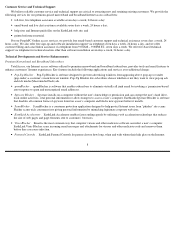Earthlink 2005 Annual Report Download - page 18
Download and view the complete annual report
Please find page 18 of the 2005 Earthlink annual report below. You can navigate through the pages in the report by either clicking on the pages listed below, or by using the keyword search tool below to find specific information within the annual report.
As competition in the telecommunications market continues to intensify, competitors may continue to merge or form strategic alliances
that would increase their ability to compete with us for subscribers. These relationships may negatively impact our ability to form or maintain
our own strategic relationships and could adversely affect our ability to expand our customer base.
Because we operate in a highly competitive environment, the number of subscribers we are able to add may decline, the cost of acquiring
new subscribers through our own sales and marketing efforts may increase, and/or churn may increase. Increased churn rates indicate more
customers are discontinuing services which results in a decrease in our customer base and adversely impacts revenues.
Competition in the Telephony Market
The market for VoIP services is emerging, intensely competitive, and characterized by rapid technological change. Many traditional
telecommunications carriers and cable providers offer, or have indicated that they plan to offer, VoIP services that compete with the services
we provide. Competitors for our VoIP services include established telecommunications and cable companies; Internet access companies
including AOL, MSN and United Online; leading Internet companies including Yahoo!, eBay and Google; and companies that offer VoIP-
based services as their primary business, such as Vonage. In addition, some competitors, such as telecommunications carriers and cable
providers, may be able to bundle services and products that we do not offer with VoIP telephony services. These services could include various
forms of wireless communications, voice and data services, and video services. This form of bundling would put us at a competitive
disadvantage if these providers can combine a variety of service offerings at a single attractive price. We can provide no assurance that our
VoIP services will achieve significant consumer adoption or, even if such services do achieve consumer adoption, that our VoIP services will
generate growth in subscribers or revenues.
Many of our current and potential competitors for VoIP services have longer operating histories, are substantially larger, and have greater
financial, marketing, technical, and other resources. Many also have greater name recognition and a larger installed base of customers than us.
Because of their greater resources, many current and potential competitors may be able to lower their prices substantially, which could
eliminate our ability to offer price-competitive services. As a result, our VoIP customer base and revenues would be adversely affected.
Competition for Other Services
We compete for advertising revenues with major ISPs, content providers, large web publishers, web search engine and portal companies,
Internet advertising providers, content aggregation companies, social-networking web sites, and various other companies that facilitate Internet
advertising. Many of our competitors have longer operating histories, greater name recognition, larger user bases and significantly greater
financial and sales and marketing resources than us. This may allow them to devote greater resources to the development, promotion and sale
of advertising services.
The companies we compete with for Internet access subscribers also compete with us for subscribers to value-added services, such as
email storage and security products. In certain cases, companies offer value-added services for free, and we can provide no assurance that our
offerings will remain competitive or commercially viable. While the personal web hosting business is fragmented, a number of significant
companies, including Yahoo!, currently compete actively for these users. In addition, the personal web hosting industry is very application
specific, with many of the competitors focusing on specific applications, such as photo sharing, to generate additional users. We can provide no
assurance that any of these value-added services will remain competitive or will generate customer and revenue growth.
17
























